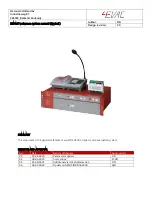
Chapter 2: Transducer Installation
55
8. Lubricate the O-ring with silicone grease or petroleum jelly. Slide the O-ring
onto the transducer assembly (see Figure 2-23 ).
Figure 2-23: Installing the O-ring
9. When the adhesive on the base has cured, pour 2.4 fl. oz. (71 mil) of mineral
oil into the base.
10. Lock the transducer assembly into the base by inserting the keys on the lock-
ing ring in the notches in the base. Press down and rotate clockwise until
seated (see Figure 2-22 ).
11. Route the cable to the transducer, being careful not to tear the cable jacket
when passing it through the bulkhead(s) and other parts of the boat.
12. Attach the connector nut to the cable per instructions in
Transducer Cable
Connections
on
page 26
.
13. Attach the assembled connector cable to the transducer.
14. Route the other end of the cable to the DSM, being careful not to tear the
cable jacket when passing it through the bulkhead(s) and other parts of the
boat. To reduce electrical interference, separate the transducer cable from
other electrical wiring and the engine.
15. Coil any excess cable and secure it in place using tie-wraps to prevent dam-
age.
Note:
If you are using an extension cable, be sure to locate the mated 3-pin connectors
well above the bilge waterline. To facilitate this, use cable clamps on either side of the con-
nection.
Installation in a Cored Fiberglass Hull
Installation in a cored hull is difficult. The objective is to bond the sensor to the
inside surface of the hull’s outer skin while preventing any moisture from
penetrating the core.
D5005-2
Front view
Side view
'O' ring
Locking
ring
Transducer
housing
















































